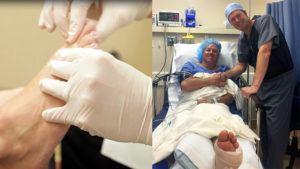When someone is diagnosed with unmanageable blood glucose levels, diabetic foot care becomes essential. If left untreated, the foot conditions can lead to life-threatening results.
People with diabetic disorders must be extra cautious when it comes to foot care.
The metabolic disorder damages nerves and when combined with poor blood circulation, it makes healing slow and increases the risk of infection.
In today’s post, we will underline the two alarming states i.e. peripheral neuropathy (nerve damage) and peripheral vascular disease (poor blood circulation). Both these abnormalities are the underlying cause of limb-threatening conditions. It is important for diabetics to understand how to overcome the conditions and take extra care of their feet so that the risk of amputation can be lessened.

Diabetic peripheral neuropathy
Peripheral neuropathy is described as nerve damage in either hands, feet or legs. Almost half of the patients who are diagnosed with type 2 diabetes have some level of nerve damage.
With increased blood sugar levels, the walls of small blood vessels get weak and the amount of nutrients and oxygen sent to the nerves gets reduced. As a result, the nourishment of nerves gets disrupted and they start to create problems.
You can consult a podiatrist to get your feet assessed for the stage of peripheral neuropathy. Your foot doctor will conduct a physical exam or take the help of advanced imaging techniques to find out the below listed signs of nerve damage:
- Tingling sensation
- Increased sensitivity to touch
- Increasing numbness
- Changes in temperature
- Slow healing ulcers
It is highly recommended to regularly visit a podiatrist for a foot check because nerve damage can make the healing process slow. Regular evaluation can help you with timely diabetic foot ulcer treatment and you can get rid of the problem before it gets worse.
Peripheral vascular disease
Unmanaged blood glucose levels can also make the blood vessels narrow and hard, which eventually impairs the blood flow.
Healthy blood circulation is essential to keep the senses in your feet alive. Blood flow problems lead to
- Painful cramping
- Leg numbness
- Coldness in lower legs
- Sores on toes
- Thin and shiny skin
Unhealthy blood flow levels make it difficult to sense the cuts and sores on the feet. Moreover, the slow healing process makes diabetics prone to life threatening ulcers and gangrene. Therefore, the problem must be addressed before the infection spreads throughout the lower limbs and amputation becomes the last option.
Proper and regular care can avoid diabetic foot conditions
Diabetes affects the blood flow, damages the nerves and makes you prone to slow healing sores and ulcers. Therefore, routine foot checks are essential. Regular examination is the only way to reduce the risk of diabetic foot conditions. To reduce the impacts of nerve damage and unhealthy blood flow, you can consult a podiatrist and focus on the below mentioned suggestions:
- Diabetes management:Regularly check your blood glucose levels. Be regular with your appointments and prescribed medications. Rigorous management of diabetes is the secret to preventing the risk of hardening of vessels and damage of nerves.
- Daily foot care: Keep your feet clean, dry and warm. Use lukewarm water to get rid of all the dirt and debris. Apply a hydrating lotion to manage dry and flaky skin. Avoid applying between toes, the trapped moisture can invite fungal infection.
- Routine expert care: Schedule an appointment on a weekly basis to get your toenails trimmed. The experts can take care of thorough cleaning of your feet. Their evaluation methods are more reliable to check any early signs of wounds and sores that may lead to infection when left ignored.
- Footwear modifications: Loss of sensations and coldness can be treated with the right pair of socks and shoes. Consult your podiatrist about the new balance diabetic shoes that don’t constrict your feet and provide the desired amount of support.
- Periodic foot exams: Get your feet checked regularly by a podiatrist. Annual or bi-annual assessments are important to get your feet checked for the stages of nerve damage and blood flow levels.
- Lifestyle modifications: You must exercise regularly to manage healthy flow of blood to the legs. Moreover, smoking is also bad for blood flow levels, quit smoking as soon as possible.
Schedule an appointment now
If you are diagnosed with diabetes and worried about the level of nerve damage or affected blood flow levels then you must get your feet checked right now. Millions of diabetics trust the podiatrists at Orange County Foot and Ankle Group for routine foot checks. They have vascular specialists and expert neurologists who offer top-rated diabetic foot care.
The specialized treatment includesthe prevention of non-traumatic foot amputation which is increasing at an alarming rate in the USA. For enhanced feet safety from diabetic ulcers, you can also consult the experts at Orange County Foot and Ankle Group for Epifix. It is a bioactive tissue matrix available in sheet, mesh and particular configurations. Apart from ulcer treatments, a routine check is also useful for diabetics to reduce their health care costs and improve the quality of their life.
Seek medical guidance right now to attain the following benefits:
- Blood sugar level management
- Debridement of wounds
- Infection treatment
- Reduced pressure on feet
- Restoring healthy blood flow
Call today and consult the top podiatrists at Orange County Foot and Ankle Group. Theyprovide the gold standards of care for optimum healing of foot ulcers, footwear modification, routine foot care andSports Injuries treatment.